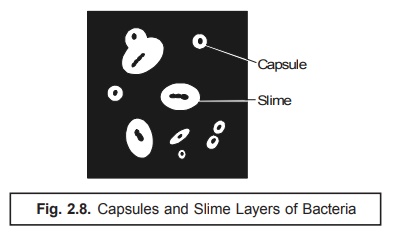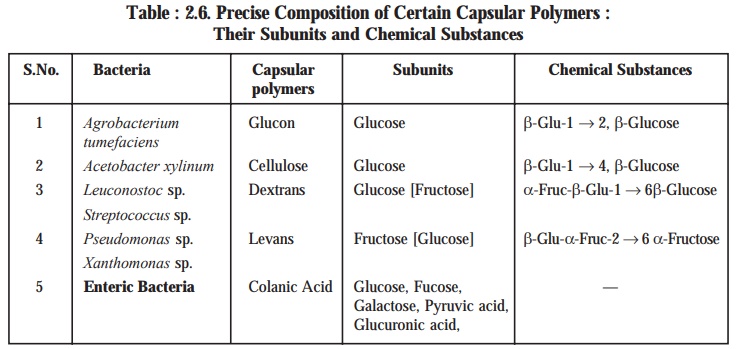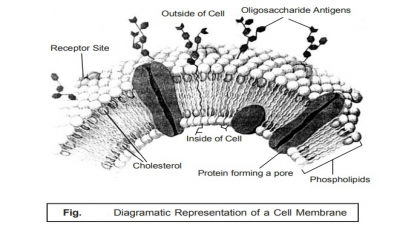Capsules and Slimes
| Home | | Pharmaceutical Microbiology | | Pharmaceutical Microbiology |Chapter: Pharmaceutical Microbiology : Structure and Function of Bacterial Cells
Invariably certain bacterial cells are duly surrounded by a viscous material that essentially forms a covering layer or a sort of envelope around the cell wall.
Capsules and Slimes
Invariably certain bacterial cells are duly surrounded by a viscous material that essentially forms a covering layer or a sort of envelope around the cell wall. In the event this specific layer may be visualized by the aid of light microscopy employing highly sophisticated and specialized staining tech-niques, it is known as a capsule; in case, the layer happens to be too thin to be observed by light microscopy, it is called as a microcapsule. If the layer does exist in an absolute abundance such that quite many cells are found to be embedded in a common matrix, the substance is termed as a slime.
In other words, the terminology capsule usually refers to the layer both intimately and tightly attached to the cell wall ; whereas, the slime coating (layer) is contrarily the loose structure which often gets diffused right into the corresponding available growth medium as depicted in Fig. 2.8 below :

Salient features : The salient features of capsule and slime are enumerated as under :
(1) These structures are not quite necessary and important for the normal growth and usual survival of the bacterial cells but their very presence grants some apparent advantages to the bacterial cells that contain these structures.
(2) A plethora of bacteria are incapable of producing either a capsule or a slime ; and those which can do so would certainly lose the ability to synthesize legitimately these two compo-nents devoid of any adverse effects.
(3) The prime interest in these amorphous organic exopolymers i.e., capsules and slimes, was to assess precisely their actual role in the pathogenicity by virtue of the fact that majority of these pathogenic microorganisms do produce either a capsule or a slime.
It is worthwhile to mention here that the composition of such amorphous organic exopolymers varies according to the particular species of bacteria. In certain instances these are found as homopolymers essentially of either carbohydrates (sugars) or amino acids, whereas in other cases these could be seen as heteropolymers essentially of carbohydrates/substituted carbohydrates e.g., heteropolysaccharides.
A few typical examples of specific microorganisms (bacteria) having a varied range of amor-phous organic exopolymers are as given below :

Further investigative studies on different types of organisms (bacteria) have revealed, the precise composition of a few selective capsular polymers (i.e., amorphous organic exopolymers) along with their respective subunits and chemical substances produced at the end, as provided in Table 2.6.
Table : 2.6. Precise Composition of Certain Capsular Polymers : Their Subunits and Chemical Substances

Important Points :
There are five important points that may be noted carefully :
(i) It is still a mystery to know that on one hand in certain bacteria the exopolymers are seen in the form of capsules ; whereas, on the other they are observed in the form of slimes.
(ii) Mutation* of capsular form to the corresponding slime forming bacteria has been well established.
(iii) Structural integrity of both the capsule as well as the slime are meticulously estimated by the critical presence of distinct chemical entities.
(iv) In many cases, the capsular material is not extremely water-soluble ; and, therefore, fails to diffuse rapidly away from the cells that eventually produce it.
(v) In certain other instances the capsular material is highly water-soluble ; and hence, either gets dissolved in the medium instantly or sometimes abruptly enhancing the viscosity of the broth in which organisms are cultured respectively.
Functions of Capsules :
In reality capsules may serve five cardinal functions exclusively de-pending upon their respective bacterial species as described under:
(a) They may afford adequate protection against temporary drying by strategically bound to water molecules.
(b) They may cause absolute blockade of attachment to bacteriophages.
(c) They may be antiphagocytic* in nature.
(d) They may invariably promote attachment of bacteria to surfaces, such as : Streptococcus mutans — a bacterium that is directly linked to causing dental caries, by means of its ability to adhere intimately onto the smooth surfaces of teeth on account of its specific secretion of a water-insoluble capsular glucan.
(e) In the event when the capsules are essentially made up of compounds bearing an ‘electrical charge’, for instance: a combination of sugar-uronic acids, they may duly help in the pro-motion of the stability of bacterial suspension by preventing the cells from aggregating and settling out by virtue of the fact that such cells having identical charged surfaces would have a tendency to repel one another predominently.
Related Topics

